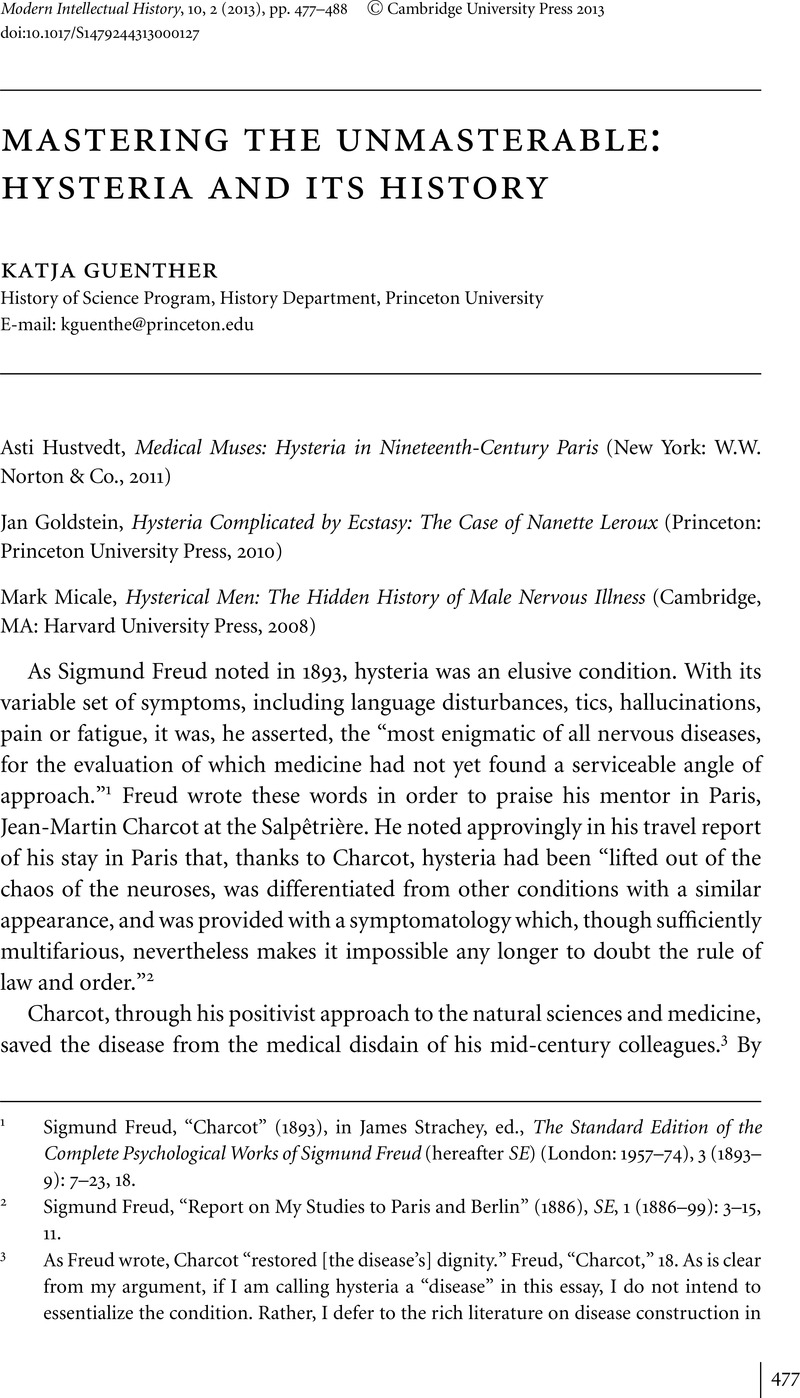No CrossRef data available.
Article contents
MASTERING THE UNMASTERABLE: HYSTERIA AND ITS HISTORY
Published online by Cambridge University Press: 11 July 2013
Abstract

- Type
- Review Essays
- Information
- Copyright
- Copyright © Cambridge University Press 2013
References
1 Freud, Sigmund, “Charcot” (1893), in Strachey, James, ed., The Standard Edition of the Complete Psychological Works of Sigmund Freud (hereafter SE) (London: 1957–74), 3 (1893–9): 7–23, 18Google Scholar.
2 Sigmund Freud, “Report on My Studies to Paris and Berlin” (1886), SE, 1 (1886–99): 3–15, 11.
3 As Freud wrote, Charcot “restored [the disease's] dignity.” Freud, “Charcot,” 18. As is clear from my argument, if I am calling hysteria a “disease” in this essay, I do not intend to essentialize the condition. Rather, I defer to the rich literature on disease construction in the history of medicine, which emphasizes the social and cultural determination not only of culturally resonant conditions such as hysteria or chronic fatigue syndrome, but also of more somatic conditions such as coronary heart disease. Cf. Rosenberg, Charles E. and Golden, Janet, eds., Framing Disease: Studies in Cultural History (New Brunwick, NJ, 1992)Google ScholarPubMed; Aronowitz, Robert A., Making Sense of Illness: Science, Society, and Disease (Cambridge, 1998)Google Scholar.
4 Goldstein, Jan, Console and Classify: The French Psychiatric Profession in the Nineteenth Century (Chicago, 2001), 326 ffGoogle Scholar.
5 Goetz, Christopher G., Bonduelle, Michel and Gelfand, Toby, Charcot: Constructing Neurology (New York, 1995), 192 ffGoogle Scholar.
6 Sigmund Freud, “Studies on Hysteria” (1893), Fräulein Elisabeth von R., SE, 2 (1893–5): 135–81.
7 For a detailed discussion see Micale, Mark S., Approaching Hysteria: Disease and Its Interpretations (Princeton, NJ, 1995), esp. 56–66Google Scholar and 88–97.
8 Gilman, Sander L., King, Helen, Porter, Roy, Roussau, G. S. and Showalter, Elaine, Hysteria Beyond Freud (Berkeley, CA, 1993)Google Scholar.
9 Much of Hustvedt's analysis relies on published medical accounts of the time. The format of the (trade-published) book can make it difficult at times to track her evidence.
10 Showalter, Elaine, Hystories: Hysterical Epidemics and Modern Media (New York, 1997)Google Scholar.
11 See Rosenberg, Charles E., The Cholera Years: The United States in 1832, 1849, and 1866 (Chicago, 1987)CrossRefGoogle Scholar for a classical account. In contrast to Rosenberg, however, who explores three cholera epidemics in New York City over the course of the nineteenth century, Goldstein, in her “sampling,” does not draw on the temporal element.
12 The idea that a de-gendered view of hysteria was predominant in the eighteenth century is standard in the literature; see Goldstein, Console and Classify. This does not, of course, mean that gendered notions did not exist in certain realms. See in particular Diderot's essay “Sur les femmes” (1772), in Oeuvres, ed. André Billy (Paris, 1951).




